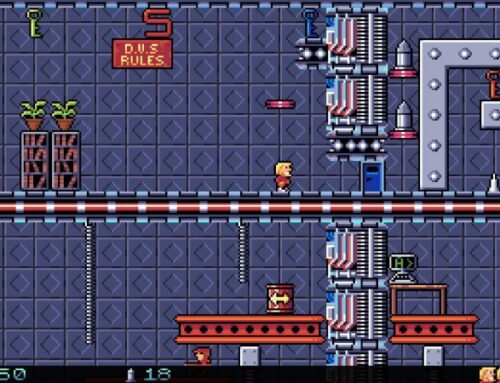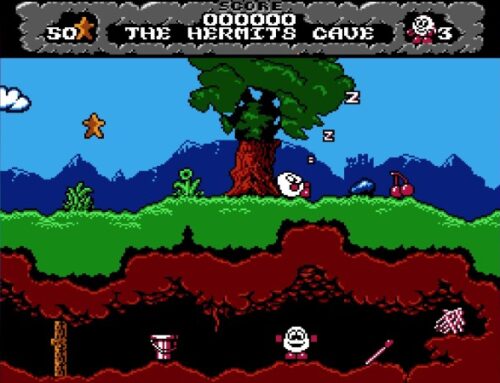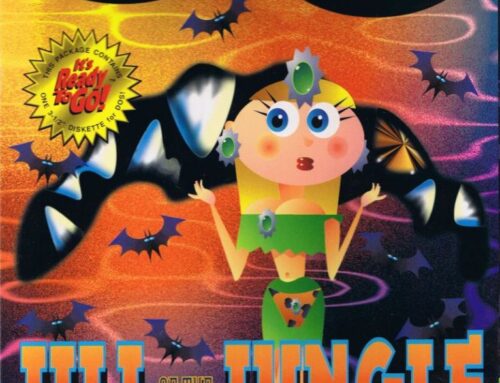We can’t look back at classic spooky games from retro gaming history without paying homage to Atari’s Haunted House from 1982. Alongside Mattel’s Night Stalker from the same year, this game played a significant role in defining what we now know to be survival horror: games in which you play a fragile player character, have a goal to accomplish which isn’t necessarily violent, and are up against powerful opponents.
In contrast to Night Stalker, which is an endless arcade-style score attack game, Haunted House is a rare example of an Atari 2600 game that you can actually “beat”. Your goal in each of the nine available game modes is to locate three pieces of a magical urn and return them to the entrance of the titular haunted house in order to break a curse; naturally, the supernatural forces which are currently inhabiting said house are not too happy about you doing this and will do everything in their power to stop you.

As you might expect, Haunted House, developed by one James Andreasen, takes some heavy cues from Warren Robinett’s Adventure, which came out two years earlier. Haunted House unfolds from a top-down perspective, much like Adventure, and your primary interaction with the game is through acquiring objects — only one of which you can hold at a time — and making use of them in various situations in order to progress.
There’s an important difference, though; while Adventure features a mix of straightforward rooms where everything is fully visible and “labyrinths” where you can only see a small area around your player, Haunted House unfolds almost entirely in the dark.
Well, that’s not quite true; Haunted House doesn’t feature labyrinths in the same way that Adventure does; every room is a large rectangle with one or more doors leading in each direction, so navigating generally isn’t too much of a problem. That said, the game does feature locked doors which require you to find a “master key” item before you can pass through them, and in all game modes aside from the first, the walls are darkened, meaning you’ll either need to find your way around by “touch” or by using your unlimited stock of matches that you’ve brought with you.

The matches are also the only way you’ll see the items that are in the various rooms; without them they’ll be hidden. This includes the three pieces of the urn, so you’ll need to keep a match lit in order to achieve your goal.
While you can only carry one object at a time, if you collect another piece of the urn while you’re already carrying one, you’ll “stick” them together and turn it into a single object. Thus it’s a good idea to try and track down the three pieces as quickly as possible and assemble it into a single item — even if you’re not going to make a run for the exit straight away.
And the reason you might not want to make that run for the exit immediately is that at some point you will be chased by the various denizens of the house. Depending on the level you’re playing on, you may come up against tarantulas, bats and even the ghost of Old Man Graves himself; each of these will scare you to death on contact, causing you to lose one of your nine lives — and on higher difficulty levels, they might even inconvenience you further by taking away your items.

You’re not completely defenceless, however; if you can track down the sceptre in the house, you can dispatch your foes safely and keep yourself safe. That is, unless you’re playing the eighth and ninth difficulty levels; on these, Old Man Graves’ ghost is immune to the effects of the sceptre — so if you see him, it’s time to run like hell!
The other twists that the various difficulty modes provide include whether or not there are locked doors in the house, how many creatures are pursuing you and whether any elements of the game — such as where the objects start — are randomised. The Atari 2600’s left difficulty switch also affects whether or not the mansion is periodically lit up by flashes of lightning or if you’re kept constantly in the dark; this is noteworthy, since your final “score” for a successful run is determined by a combination of how many matches you used and how many lives you lost along the way.
An interesting element of Haunted House that has very much carried forward to modern survival horror is the use of sound; much as today’s survival horror titles make sound an important part of determining where enemies are, so too does Haunted House make extensive use of audible cues to provide you with feedback. You’ll hear sounds for you bumping into walls and finding locked doors, allowing you to navigate without using matches. The wind will sometimes blow and extinguish your match. And when passing through a door, a rising or falling scale tells you if the door is actually a staircase to another floor.

Haunted House is well worth playing today; despite its simplistic visuals and sound, it has a genuinely creepy atmosphere about it, and it presents an interesting, mentally stimulating challenge, particularly on its higher difficulty levels. Dealing with the monsters on the harder settings can be frustrating — but successfully clearing one of these tough challenges for the first time is immensely rewarding. It’s particularly satisfying to successfully find the myriad alternative routes through the mansion — since you can’t carry the urn and the key at the same time, this is essential to success on higher levels!
If you want to give Haunted House a go for yourself today, it’s readily available; for current systems, it’s available as part of the Atari Flashback Classics collection (volume 2 on PS4 and Xbox One; the Switch and Vita versions include all 150 games), and it’s also available as part of the Atari Collection 2 cartridge for the Evercade.





